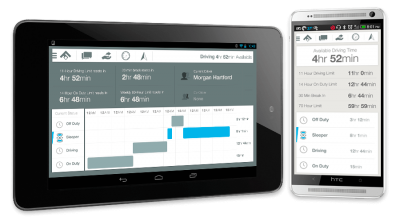
Under the Federal Motor Carrier Safety Administration rules in the United States, that came into effect on Dec. 18, 2017, most trucks built after 2000 had to be equipped with an ELD (Electronic Logging Device). Fleets already using older electronic onboard recorders are grandfathered until December 2019.
The CCMTA (Canadian Council of Motor Transport Administrators) is coming forward with a Canadian ELD Mandate proposal. The Canadian ELD rules will closely mirror the US mandate to keep cross-border regulations consistent.
Regardless of when the Canadian government publishes the final rule on ELDs, which will likely be within the next year, any driver operating a commercial motor vehicle south of the border is already required to follow U.S. Hours of Service rules and regulations. Canadian carriers that make cross-border deliveries were also required to have an ELD solution by the December 2017 deadline.
Shippers and Carriers have now had a couple of months to digest the impacts of the ELD mandate. These are some of the lessons learned.
1. Shippers Need to Address Obstacles or Pay the Price
The strict observance of the HOS rules legally affects a driver’s freight delivery schedule. ELDs provide carriers with quality data on the activities of their drivers throughout their working day.
Shipper/receiver docks will play a big role in keeping drivers on time. With truck idle time being captured by ELDs, it will quickly become clear who the culprits are in making drivers wait. Shippers should stick to appointment times, preload trailers, and take other steps to make drivers more efficient.
ELDs highlight the location of problem shippers and provide direction to sales personnel to educate customers on lengths of haul and pick-up and delivery requirements. This includes issues such as dock doors and parking spaces.
Shippers are encouraged to expand their hours of operation. A couple of hours on either end of the current hours could make a difference in terms of ability to receive freight on time and keep detention charges to a minimum. Adding some flexibility on pickup and delivery times can also be helpful. The ELD mandate has heightened the requirement for shipper-carrier communication and collaboration. Shippers that don’t fix their freight management processes will face documented charges.
2. Load Planners and Shippers need to Improve their Planning
Load planners need to work closely with shippers to be clear as to which delivery to take next and to ensure that that the next load is ready for pick up or delivery in a very timely manner. As highlighted in a previous blog (https://www.dantranscon.com/index.php/blog?view=entry&id=307 ), the industry needs to move to precision trucking. The era when a driver arrives at a distribution centre after a long haul run and must wait until their load planner decides which delivery to take next cannot persist into the future. Load planners must be “planners,” not reactors.
3. Be Knowledgeable on One and Two-Day Freight Movements
With the ELD mandate, load planners need to look for either one-day freight moves of a maximum length of 500 miles or two-day freight moves that reach up to 1,000 miles. Truckers need to think through their plans for loads moving 600 to 700-mile length of haul in terms of service commitments and rates. This has implications for sales, pricing, operations and for shippers that move freight in corridors of this length.
4. Expand the Routing Guide Carriers are adapting to the ELD mandate
This includes demarketing freight on certain lengths of haul or dropping uncollaborative shippers. With tight capacity, carriers are allocating their trucks to the loads that best fit within their operations and pay the best rates. To protect themselves, shippers need to have frank discussions on capacity and rates with their core carriers and bolster their routing guides with other players that can effectively serve their companies.
Freight brokers often have access to small, less well-know carriers that some shippers may not be aware of. Smart shippers should keep some freight brokers as options on lanes where there are challenges in finding capacity.
5. Consider alternate Modes
There may be times where HOS rules preclude a truckload movement on certain corridors on certain dates. The shipper may need to consider maintaining LTL providers in their routing guides in some situations. In other cases where the shipper has more flexibility in terms of transit time, intermodal service may be an option.
6. Use a TMS for Load Tendering
All transportation providers and their rates can be entered into a shipper’s Transportation Management System (TMS). Using a TMS, shippers can select carriers on certain lanes and use sequential tendering to find the best service in tight capacity conditions. In these strong economic times, shippers cannot afford to spend their days on the phone searching for carriers.
7. Make Contractual Commitments based on Service, Capacity and Rates
Shippers should work with carriers on commitments based on a combination capacity, service, and rates. Sign multi-year contracts to lock in these commitments. Shippers should go to the spot market for the remainder of their loads, as a last resort. Without commitments on a substantial percentage of the volume, shippers could run short on capacity at critical times and/or pay some very steep spot market rates.
To stay up to date on Best Practices in Freight Management, follow me on Twitter @DanGoodwill, join the Freight Management Best Practices group on LinkedIn and subscribe to Dan’s Transportation Newspaper (http://paper.li/DanGoodwill/1342211466).



















